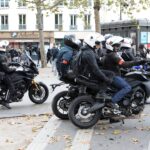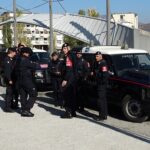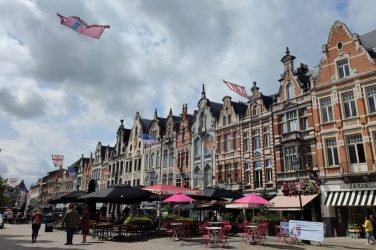This piece is not a tour guide – it is rather a short and relatively stream-of-consciousness reflection and a portrait of the city, using two other cities that are dear to my heart.
Prague – called the City of a Hundred Spires, the Golden City, the Mother of Cities. In a manner like few other cities, Prague always resonates to me with echoes, always reminding me of other times, other places and other realities.
Echoes of the Drunks in the Street outside my Window
When arriving at the airport or walking around in the centre, you are faced with a billboard campaign calling you to “treat the Mother of Cities as you would your own mum” – an imploration to the traditional invasion of British stag parties seeking a cheaper Amsterdam (and much cheaper it remains, as a pint of beer still goes for two euros, despite all other prices rising by 50-100% in the past couple years).
Amsterdam was the first association that came to my mind when I arrived in Prague – though the latter is quite misunderstood by those seeking a discount Amsterdam.
While it is impossible to walk down a tourist street without running into obnoxious flashing signs for “weed shops” promising pre-rolled blunts, edibles and all kinds of marijuana & THC derivatives for the unsuspecting tipsy tourist, they all, without exception, sell vastly overpriced CBD weed unlabeled as such. Scamming tourists is a thriving economy – stay away from moneychangers (even some official looking ones), taxi drivers, anyone proposing for you to take a picture with some animals, and most street peddlers.
While Czechia is indeed lax about weed, it is not (yet) legal. And Prague is no Amsterdam and has no aspirations to be. The local equivalent to the openly tolerated, clean and business-like Dutch coffeeshops are small, hidden and dingy bars, regularly shut down, where if asked in a discrete manner, the bartender or some person he points to will sell you something to smoke. And while in Amsterdam, the hard drug of choice is ecstasy, Prague holds the infamous title of Europe’s methamphetamine capital.
Sex work, the second element of a sin city, is in a legal grey zone in the Czech Republic – while not explicitly prohibited, any form of organised sex work is forbidden, as opposed to Amsterdam organised sex work is not. This means that sex workers walk the streets or are hidden in illegal brothels (of which there are hundreds), far from sight and oversight, placing workers in a much more precarious and unsafe position.
Echoes of Past Lives and Far-Away Places
Of course, both cities have much more beauty and wonder to offer beyond parties, drugs and sex – from breathtaking art, ancient castles and buildings, to the same kitschy museums of sex toys or illusions. They even both proudly present the exact same commercialised horror that is the (unauthorised) Banksy Exhibition, which is a staple in any tourist trap.
As you flee the crowds of tourists and the accompanying economy of fake money changers and scamming taxi drivers, the layers of Prague unfold under your steps. If you look up while walking the streets, you see remnants and echoes of Austria-Hungary, Nazi Germany, and communist rule. There are beautiful old synagogues and ancient German street names painted on the building walls above the modern signs in Czech: in the mid-1800s, only a few generations ago, close to a majority of residents were German speaking, and that for the vast majority of Prague’s history, it was ethnically mixed between Germans, Czechs and Jews.
Such cultural richness and cosmopolitanism makes me think of Sarajevo – another city in which there are very few Jews left today. At the other end of the former Austrian-Hungarian empire, it was also not long ago a thriving nexus for Jewish culture and religion, marked in part by a similar Germanic influence and enveloped by its Ottoman legacy.
The dominating features in the centre of both cities are the beautifully decorated old Austro-Hungarian tenement buildings. While the nexus of Sarajevo is the old Ottoman Bazaar, in Prague it is rather the old Jewish quarter. The suburbs of both cities are alternatively populated by imposing, aesthetically dubious plattenbau, or by charming single houses with gardens. In both cities, all this is interspersed with optimistic modernist experiments in design, expressing an idealistic challenge and hope for the future; most of which have fallen into depressive disrepair, with a few judged valuable enough for upholding and protection.
Further parallels: Both Sarajevo and Prague have been the place where the East meets West. In the case of Prague, it was a bridge to Eastern Europe, Ukraine and Russia, while Sarajevo marked the path to Turkey and the “Orient”. And both cities were recently under (quite different) authoritarian communist regimes within now dissolved multinational states – though Yugoslavia fell apart in fire, and Czechoslovakia with a handshake.
Echoes of Boos and Cheers
Minuses in Prague: a severe lack of nice cafes with outside seating. Cobblestone roads, the absence of bike lanes and the overwhelming car traffic in the centre of the city makes biking as a form of transport life threatening – after Amsterdam and Berlin, this is the first city in which I wore a bike helmet, before giving up on the concept altogether. Crosswalk lights take an infuriating amount of time to switch to green, then leave you with about five seconds to get to safety on the other side. And despite the German influence, generally terrible bread.
Pluses in Prague: gorgeous light shining over the countless rooftops and towers. Beautiful and intricately created facades on the old buildings. Great and cheap public transport. Delicious Vietnamese food. Thriving art and music scene. Always a spot to be found on a hill overlooking the city, or somewhere by the water to watch ducks, swans and coypu.
It’s a wonderful city which I encourage you to visit, for the right reasons.
All photos by the author.



















